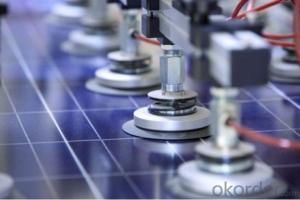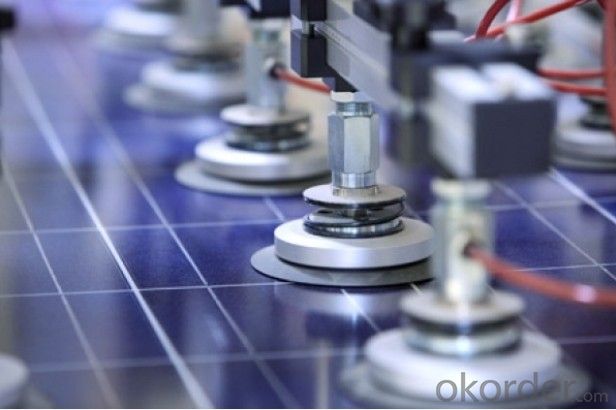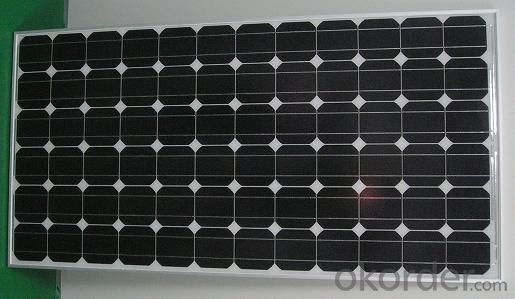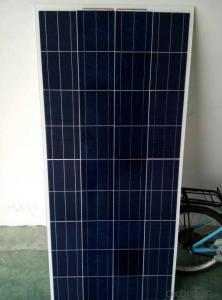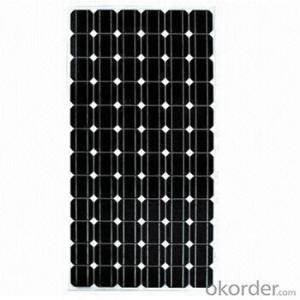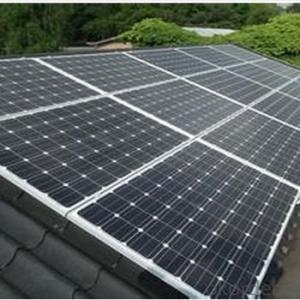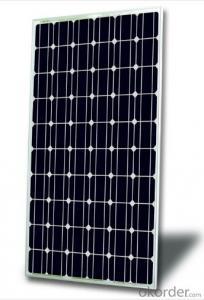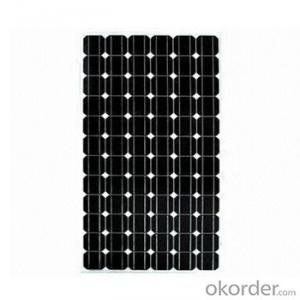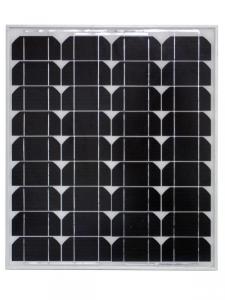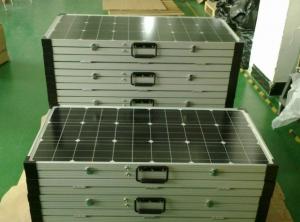Sungold Solar Panels - Monocrystalline Solar Panels Tire 1 Brand in China - 185-190W
- Loading Port:
- Shanghai
- Payment Terms:
- TT OR LC
- Min Order Qty:
- 10000 watt
- Supply Capability:
- 500000 watt/month
OKorder Service Pledge
OKorder Financial Service
You Might Also Like
Product Description:
Solar Monocrystalline Series Panels
Introduction of Monocrystalline Solar Panels
CNBM Solar photovoltaic (PV) Panel is designed for large electrical power requirements. It is the optimal choice for both on-grid and off-grid power systems. CNBM Solar panel offers high performance of power per square foot of solar array. Monocrystalline silicon(c-Si): often made using the Czochralski process. Single-crystal wafer cells tend to be expensive, and because they are cut from cylindrical ingots, do not completely cover a square solar cell module without a substantial waste of refined silicon. Hence most c-Si panels have uncovered gaps at the four corners of the cells.
Characteristics of Monocrystalline Solar Panels
I Solar Cell : High efficiency crystalline solar cell. Even if under the weak light, the solar module can produce maximum power output.
II Tempered glass (toughened glass): Anti-reflecting coating and high transmission rate glass increase the power output and mechanical strength of solar module.
III EVA and TPT: Using high quality EVA and TPT to prevent destroying and water.
IV AI frame: Without screw, corner connection. 6 holes on the frame can be installed easily.
V Junction box: Multi function junction box with water proof.
VI Long lifetime: ≥25 years; Less power decrease
VII Good performance of preventing from atrocious weather such as wind and hails.
VIII Resisting moisture and etching effectively, not effected by geology.
Standard Test Conditions of Monocrystalline Solar Panels
The opto-electrical specifications shown below are stabilized values being measured at Standard Test Conditions, Irradiance: 1000W/m2, Spectrum: AM1.5 at 25°C, The info below is subject to manufacturing tolerances. Where appropriate minutes of measurement are available and are used for the dimensioning of the installation.
Advantages of Monocrystalline Solar Panels
• CNBM Solar performance guarantees for 25 years
• 12 years guarantee for workmanship
• Timeliness of delivery
CNBM International Corporation's products including Monocrystalline Solar Panel, Polycrystalline Solar Panel have received and enjoyed famous reputation in many countries and regions in the world .As a solar panel supplier in China, we strive to provide our customers with excellent service, superior products and unmatched value.
Characteristics of Monocrystalline Solar Panels
Characteristics of Monocrystalline Solar Panels
Max Power Voltage Vmp (V) | 36.27V | 36.5V |
Max Power Current Imp (A) | 5.1A | 5.2A |
Open Circuit Voltage Voc (V) | 45V | 45.2V |
Short Circuit Current Isc (A) | 5.5A | 5.6A |
Max Power Pm (W) | 185W | 190W |
Temperature Coefficient of Cells
NOCT | 47℃±2℃ |
Temperature Coefficients of Isc (%/℃) | 0.064 |
Temperature Coefficients of Voc (%/℃) | -0.33 |
Temperature Coefficients of Pmp (%/℃) | -0.45 |
Mechanical Data Solar Monocrystalline Series
Power | 185W/190W |
Dimension | 1580×808×40mm |
Weight | 15.5kg |
Tolerance | ±3% |
The dimension of the modules can be changed according to the demand of clients
Limits
Operating Temperature | –40 °C to +85°C |
Storage Temperature | –40 °C to +85°C |
Max System Voltage | 700V |
Guarantee Solar Monocrystalline Series Panels
Products Guarantee | 10 yrs free from defects in materials and workmanship |
Performance Guarantee | No less than 90% within 10yrs and no less than 80% within 25yrs |
Certificates | IEC, ISO, TUV, CE |
Examination of Monocrystalline Solar Panels
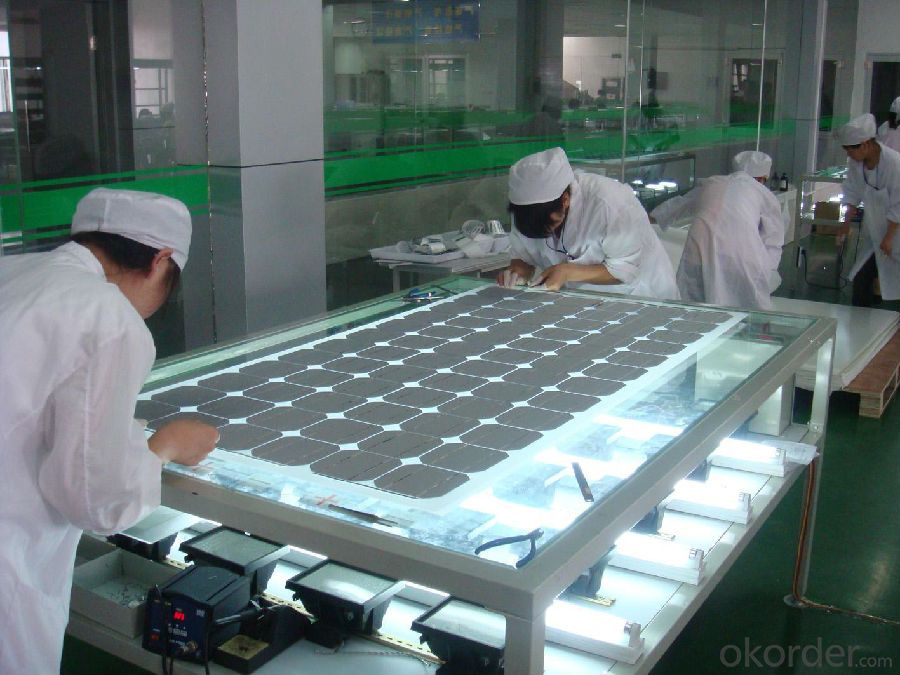
Our project reference
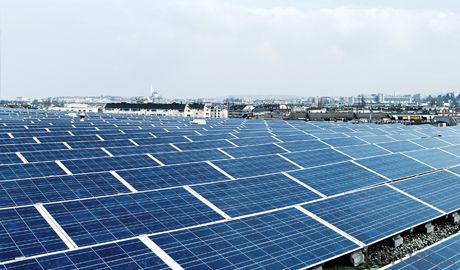
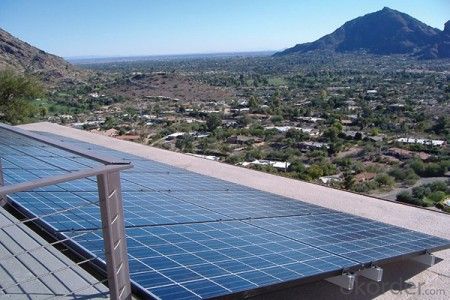
FAQ
We have organized several common questions for our clients,may help you sincerely:
1. What’s price per watt?
A: It’s depends on the quantity, delivery date and payment terms of the order. We can talk further about the detail price issue. Our products is high quality with lower price level.
2. Can you tell me the parameter of your solar panels?
We have different series of cells with different power output, both from c-si to a-si. Please take our specification sheet for your reference.
3. How do you pack your products?
We have rich experience on how to pack the panels to make sure the safety on shipment when it arrives at the destination.
4.Can you do OEM for us?
Yes, we can.
5. How long can we receive the product after purchase?
In the purchase of product within three working days, We will arrange the factory delivery as soon as possible. The perfect time of receiving is related to the state and position of customers. Commonly 7 to 10 working days can be served.
- Q: Hi All,I need some resources for a research project i'm doing on Solar Panels/Cells.So do you know of any good books or online materials that basically covers how solar cellwork from level 0 to calculating the energy output based on intensity of the light and the area of the panel. Book titles will be preferable but i'd like to build a strong base before tackling long and complicated formula(s)... so any suggestions? Your help will be appreciated :)THANKS IN ADVANCE!!
- My guess is that you must pick up everything that have to do with solar power at www.okorder .
- Q: solar panels or light parts
- They make lights that have solar panels built into them. Due to the solar cell, they can sense when it gets dark and thus switch on the light automatically. Look at Northern Tool or Harbor Freight web sites for ideas.
- Q: Can it be used on a cellphone so u never have to worry about low battery?
- What a solar panel REALLY is is a political rip-off in which the government takes money from me to help you buy solar panels that produce a fraction of the power you could have bought with the money they stole and which required more volatile chemicals to manufacture than would have been created in the consumption of that same power.
- Q: What is the warranty on solar panels?
- The warranty on solar panels can vary depending on the manufacturer and the specific product, but it typically ranges from 10 to 25 years.
- Q: Are there any government incentives or rebates for installing solar panels?
- Yes, there are several government incentives and rebates available for installing solar panels. These incentives vary by country and even state in some cases. Examples include the federal solar Investment Tax Credit (ITC) in the United States, feed-in tariffs in certain European countries, and grants or rebates offered by local governments. It is advisable to check with local authorities or consult a solar installer to determine the specific incentives available in your area.
- Q: I have a question about solar panels. What are the benefits of this system if I installed in my home. for example i know it produces electricity but does it do anything else? How many panel would you guys think I would need for 2000 sq ft. do you know if it produces hot water? Thanks for your help
- First, solar panels come in two basic types - photovoltaics, which produce electricity (the black cells you normally think of), and solar thermal, which heats water (or some other fluid). It's one or the other, you could install both if you want that. Solar thermal is cost effective today, depending on how you currently heat your water. (The hot water could also be used to create electricity, like in a steam turbine, generally done in larger power plants). Photovoltaics are more expensive, but coming down in price every day. To know how many panels you need, you first have to determine how many kWH your house uses, and do you want to be completely off the grid (which would also require large batteries), or just reduce your electric bill.
- Q: Can we cover up solar panels on our house with regular siding?
- oh my goodness. make the investment aand update them
- Q: How much electricity can a solar panel generate?
- The amount of electricity a solar panel can generate depends on various factors such as the size and efficiency of the panel, the amount of sunlight it receives, and the location. On average, a standard solar panel can produce anywhere from 250 to 400 watts of electricity per hour.
- Q: I have in mind a small solar panel that could be plugged into a wall socket. Do I need a converter or some kind of interference between the two power sources so there aren't any unpleasant explosions? I don't know much about this sort of thing so please be nice.
- You're quite right that the solar panel can't be directly connected. I sense that you want to start small, but unfortunately, it's hard enough to make a system with a dozen or more panels pay back. (It can, we have a system...) But with just one panel, maybe a small one, the economy of scale is gone. You need to buy a grid-tie inverter, which watt-for-watt will be more expensive than a regular size one, and for a small panel, the $$/watt value will be poor. There are some [illegal in most places] tiny grid-tie inverters that I see advertised on the web from time to time, with an ordinary plug that goes into the wall. Those are generally against electrical codes, and the danger is real. There is also a crop of micro-inverters being sold by companies such as Enphase. These are legitimate products, but will still be costly per watt, and ultimately, it will be hard to have a net savings over time with just one panel. Have you already taken the conservation steps like LED light bulbs, efficient appliances (especially refrigerator), insulation, and using a power strip to turn off loads that are not being used? That stuff isn't sexy, but saves money fast.
- Q: Ok, so my homework was to research and write about how solar panels and solar furnaces work and about their construction. We didn't even take one lesson on it in class and we are not allowed to copy and paste much and have to keep it simple wtf? Its soo annoying as we have hardly took it in class. Please can someone help.
- Well solar panels conduct electricity from the suns waves and turns it into dc current then it is either put into a grid tie inverter to change it to AC and it makes you meter go backwards instead of forwards. or if its not a grid tie inverter it is just put into batteries as dc then changed into AC from the inverter and then used for household appliances. nothing really does run on DC that is why it has to be changed. and for solar furnaces if you mean a water heater that works by a substance here in Pa its antifreeze is heated up by the sun in the panel it is in a continous loop and that is what gets heated up the water then flows over tow of the tube that contains what ever substance such as antifreeze and heats the water.were the water and the tube that changes the water from cold to hot is called the heat exchanger. the substance is actually get heated first then the water. solar heating for water accounts for 29% of water heating in the us. Now if you mean solar furnace as in passive solar thats completely different because here in Pa if we want it our houses have to face to south to get the suns rays. (alot more windows) and there is a cement slab placed only on the south side of the house and it has insulation covering it. There is a certain type of glass that is used for this that will allow the suns rays to come in and let the heat in for the summer and also for the winter. the main place for that would mostly be the first floor of the house due to the height of the windows and the angle of the sun(pa in the summer is 73 degrees and in the winter its 27 degrees) thats when the second floor would be ok to heat the rooms. Hopefully i helped and i explained it in a way that you can understand.
Send your message to us
Sungold Solar Panels - Monocrystalline Solar Panels Tire 1 Brand in China - 185-190W
- Loading Port:
- Shanghai
- Payment Terms:
- TT OR LC
- Min Order Qty:
- 10000 watt
- Supply Capability:
- 500000 watt/month
OKorder Service Pledge
OKorder Financial Service
Similar products
Hot products
Hot Searches
Related keywords
